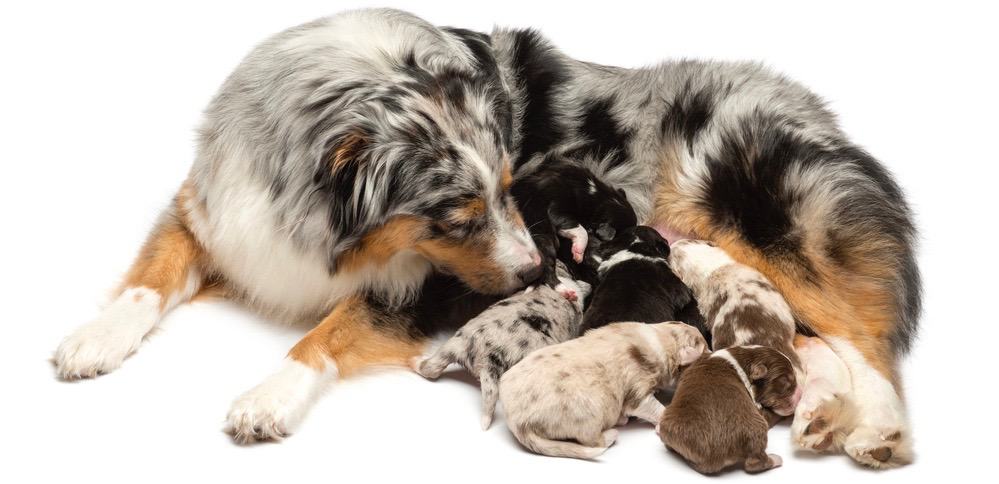Australian Shepherd Growth Chart – Aussie Weight & Size Chart
Whether you are a new Australian Shepherd owner or considering adopting an Aussie, you will need to know how big you can expect your Aussie to get.
Following an Australian Shepherd growth chart is one great method of knowing that your dog is on-track for his growth while still giving you a good idea about how big your dog will be when he is an adult.
Unlike other breeds, Australian Shepherds do not have a huge variety when it comes to their sizes. They are generally a medium-sized breed with very consistent growth.
When Do Australian Shepherds Stop Growing?
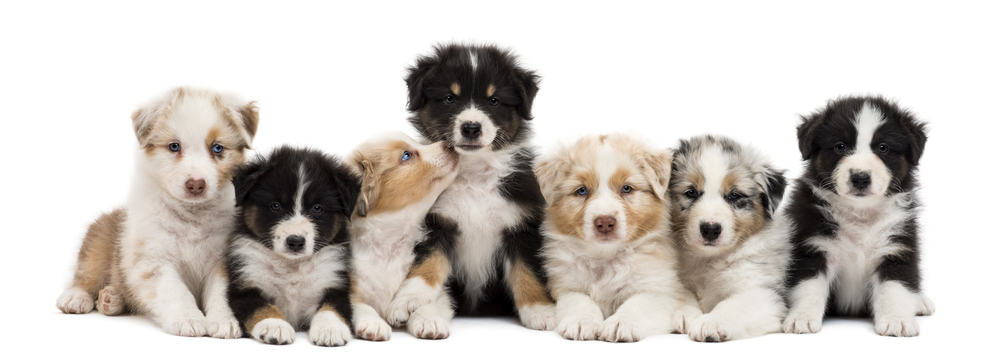
Generally speaking, Australian Shepherds stop growing when they reach 16 months of age. At this point, the male dogs should weigh around 64 pounds.
Females grow up to weigh less than male dogs. At 16 months, females should weigh around 45 pounds.
A sure way to find out whether your dog has stopped growing is to take your dog to the vet. The vet can take x-rays of the dog’s long bones to determine if the growth plates have closed and have become a stable part of the bone.
Growth plates are the soft areas at the ends of the long bones. Their function is fulfilled when they have become filled with cells that are responsible for the growth of a puppy’s bones – they let the bones become stronger and longer. When this process is complete, your dog is fully grown.
Australian Shepherd Size Chart
You can use the Australian shepherd weight chart below to estimate your Australian Shepherd’s weight and size.
As you can see, a female dog weighs about 18 pounds at three months. After that, the dog gains weight steadily with the biggest gain (5 pounds) between 3 and 4 months.
Until 6 months, the puppy gains 4 pounds every month and thereafter the gain slows down somewhat to 2 – 3 pounds per month. A female dog can reach her adult weight by 14 months, according to the chart.
A male dog weighs roughly 25 pounds at three months. This jumps to 32 pounds at 4 months, 39 pounds at 5 months and 45 pounds at 6 months. After that the dog keeps on gaining 3 or 4 pounds per month and that slows down to 1 pound per month when the dog reaches 10 months.
Remember the Australian shepherd weight chart is an estimate. Your puppy doesn’t have to weigh exactly what the chart indicates, his weight can vary a bit.
Australian Shepherd Weight Chart
| Age in Months | Average Male Weight | Average Female Weight | Average Male Weight | Average Female Weight |
|---|---|---|---|---|
| 3 Months | 25 lbs | 18 lbs | 11 kg | 8 kg |
| 4 Months | 32 lbs | 23 lbs | 14.5 kg | 10 kg |
| 5 Months | 39 lbs | 27 lbs | 17.5 kg | 12 kg |
| 6 Months | 45 lbs | 33 lbs | 20 kg | 14 kg |
| 7 months | 49 lbs | 36 lbs | 22 kg | 16 kg |
| 8 months | 53 lbs | 38 lbs | 24 kg | 17 kg |
| 9 months | 56 lbs | 40 lbs | 25.5 kg | 18 kg |
| 10 months | 58 lbs | 42 lbs | 26.5 kg | 19 kg |
| 12 months | 60 lbs | 43 lbs | 27.5 kg | 19.5 kg |
| 14 months | 63 lbs | 45 lbs | 28.5 kg | 20 kg |
| 16 months | 64 lbs | 45 lbs | 29 kg | 20 kg |
Adult male Australian Shepherds will end up weighing 51 to 64 pounds when they are fully grown. Their height will be between 20 and 23 inches.
Female Australian Shepherds are smaller and weigh anything from 31 to 44 pounds with a height of 18 to 21 inches.
Australian Shepherd Growth Chart – What to Expect
Birth – 2 Weeks
During this stage, a puppy will have fully developed senses of taste and touch, but his eyes and ears will be closed so he won’t be able to see or hear. The puppy is totally dependent on the mother and cannot control his body temperature, so he needs his mother’s body heat to survive. By the end of the first week, the puppy will have doubled his birth weight.
During the second week, the puppy’s eyes will start to open, but his eyesight will not be fully developed. His legs will grow stronger and he will keep on gaining weight.
The mother is very attentive to her offspring and only leaves them to eat or do her toilet. She licks her puppies’ bottoms clean after a bowel movement.
3 Weeks – 12 Weeks
The puppy’s hearing and smell develop more and the eyes are now open. Teeth also start to grow. The puppy can stand on its own and show signs of being a dog by wagging its tail and trying to bark.
By the fourth or fifth week, he can see properly. At this stage, the puppies in the litter start socializing with each other, growling and wagging their tails.
By the fourth week, puppies start cutting their back teeth as they begin to wean. They now get most of their nourishment from puppy food.
Puppies are normally completely weaned by the end of the 6th week, when they should get 5-6 small portions of puppy food throughout the day. At 8 weeks, puppies are at the peak of their puppy life and ready to leave the breeder and go to their new family.

When a puppy reaches 3 months, it’s time to socialize it properly. This is the time when a puppy can become fearful. It’s also the right time to start house training.
This is also the time for a puppy’s first vaccinations during this month. By this time, most puppies are happy with only three meals a day.
4 Months – 6 Months
At about four months old, a puppy starts to look more like a dog and less like a puppy. This is still an optimal time for training.
When the puppy reaches 5 months it can go on short walks with you, but don’t let him overdo it. Just playing with toys and socializing with people is enough exercise at this point.
6-month old puppy – At this age, your dog will have reached about ⅔ of his adult weight and he will start his adolescent period.
His adult coat will start growing and he will show increased independence, but also fear and disobedience. Proper training and socialization at this stage are very important.
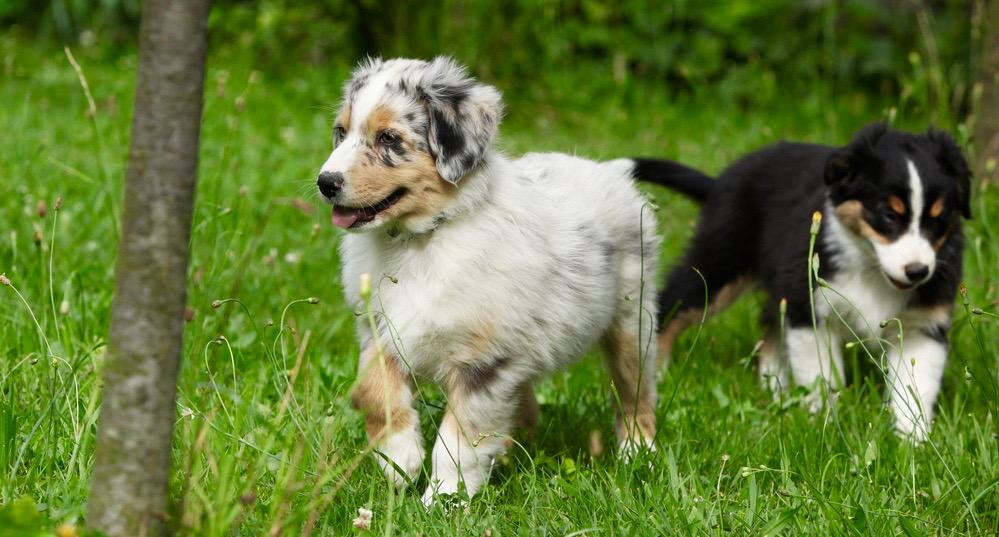
7 Months – 9 Months
Your dog is gradually growing bigger and maturing. Although your dog needs exercise every day, remember that Australian Shepherds younger than nine months should exercise with care: they shouldn’t do a lot of running and jumping, especially on hard surfaces.
Also, don’t let your 7-month-old dog go up and down stairs. His bones are still developing and too much exercise and stair climbing can damage his joints and bones.
10 Months – 12 Month
Australian Shepherds reach sexual maturity around the age of 10 – 11 months. If you have a female dog, be aware that she may experience her first heat around this time.
There is no consensus on when an Aussie should be spayed or neutered. Some vets recommend that owners should have their Australian Shepherd spayed or neutered between the ages of four and nine months.
It is thought that spaying a female dog calms them down while spaying too early can cause health problems later on.
Adult
This is a high-energy dog that has to be kept busy. An Aussie needs plenty of exercise and an easy walk in your neighborhood won’t be enough for him. If you don’t have the time or interest to exercise a dog, then an Aussie is not for you.
If you have the time and interest, your dog will excel in competitive dog sports. Aussies need a job to do and if they are not trained and kept stimulated, they are unhappy. This is not a dog you can leave in the back yard for hours.
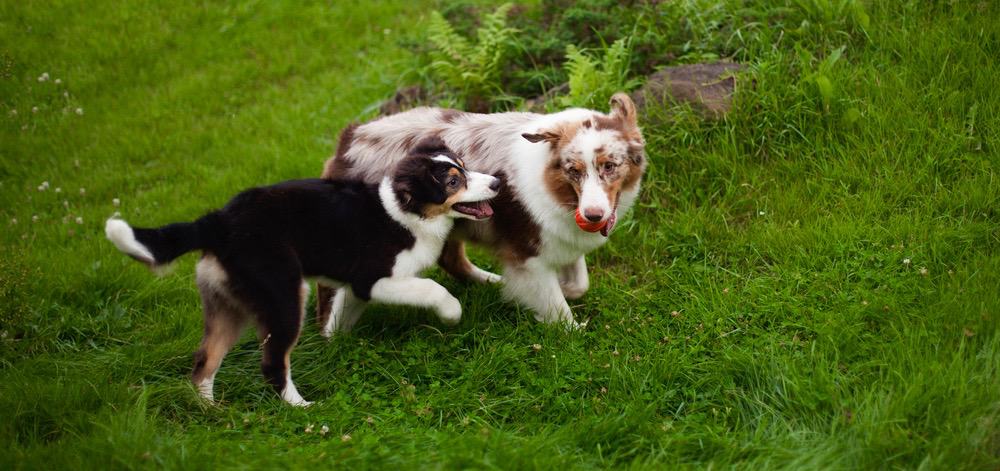
Australian Shepherds thrive in wide-open spaces and they are not the ideal apartment dogs. An apartment with a small yard is okay, provided they get regular exercise.
Length And Height Of An Australian Shepherd
The Australian Shepherd is a medium-sized breed. They stand between 18 and 23 inches (46 and 58 cm) at the withers. Females are smaller, standing 18 to 22 inches (46 to 56 cm) tall and males measure 19 to 23 inches (48 to 58 cm).
The average body length is 28 – 36 inches (71 – 91 cm).
How Big Do Australian Shepherds Get?
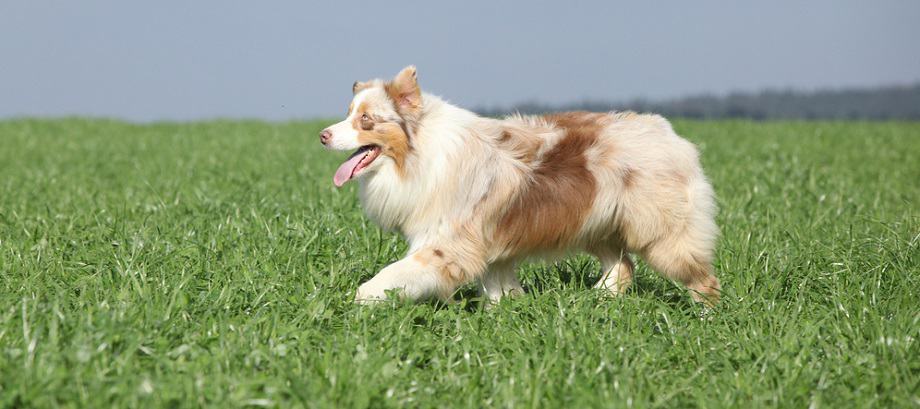
Looking at your puppy, you might be wondering exactly how big do Australian Shepherds get. There are a few things that you can use to help you get a good idea, though no method is perfect.
Beyond using the Australian Shepherd growth chart, you can first look at the dog’s parents, if they are known. The parents will give you a forecast of your own dog’s size.
You can also look at your dog’s paws and see how much growing he will have to do before the paws will fit him proportionally. There are also DNA tests available that might give you a clue as to what to expect.
When Is An Australian Shepherd Fully Grown?
If you are looking at your puppy and wondering when he will stop growing, there is not a simple answer. In general, dogs will reach their adult height by the time they reach their first birthday. This is not true for all dogs, however.
On average, Aussies will continue to grow until they are 16 months old. Given that they are not large dogs, this is unusual. Some might reach their final size at a year, but in general, it will be at around 16 months.
Your dog may reach his final height at a year, but continue to gain weight for a few more months.
Will Australian Shepherds Grow After Being Neutered / Spayed?
A common concern among dog owners is whether your dog will stop growing when he is spayed or neutered. This process is important to ensure that your dog does not conceive or impregnate unwanted puppies and is important for their overall health.
The previous concern was that with the removal of the organs, the dogs would lose hormones, affecting their growth. This is not generally the case.
American Shepherd vs Australian Shepherd Size
Given their similar appearance, Australian Shepherds and American Shepherds are often mixed together, though they are not the same breed.
Originally, the American Shepherd was known as the miniature Australian Shepherd, before the name was changed to the miniature American Shepherd. This is because they, in truth, look just like mini Aussies.
When comparing their size, the average female Aussie weighs between 40 and 55 pounds, while the males weigh between 50 and 60 pounds. The American Shepherds will weigh anywhere from 20 to 40 pounds.
Their weights are not categorized by sex, since it is generally the same. Height-wise, Aussies stand between 18 and 23 inches tall while American Shepherds are between 13 and 18 inches tall.
Australian Shepherd Body Condition Score (BCS)
When you go to the doctor for yourself, you might notice your doctor marking down your BMI, or Body Mass Index, to determine whether your weight is healthy for your height. Dogs do not have a BMI, but instead use a BCS, or Body Condition Score.
The BCS is determined on a scale system from 1 to 9. 1 is the bottom end, where a dog is severely underweight and emaciated while the 9 is the opposite end, where your dog is extremely obese. Both extremes are incredibly unhealthy.
The ideal BCS is a 5. A 5 BCS means that you can feel your dog’s ribs under his fur, but you cannot see them poking out. You also shouldn’t have to press to feel them.
Your dog’s waist should also be defined enough to see from above. If you have concerns about your dog’s BCS, talk to your vet for guidance.
How To Properly Weigh And Measure An Australian Shepherd
We can look at the Australian Shepherd size chart over and over, but if we don’t know how much our dog weighs, the chart is pointless. In order to properly weigh your Aussie, it is important to have a scale.
Since they are not too large, you should be able to easily weigh them at home. You do this by weighing yourself first and jotting it down. Then, pick up your dog and step back on the scale while holding them.
Then subtract your weight from the weight while holding the dog to know his own weight.
To measure the height of your dog, use a tape measure. While he is standing, measure from the top of his shoulder down to the ground to get the right height.
Factors That Affect Australian Shepherd Puppy Growth
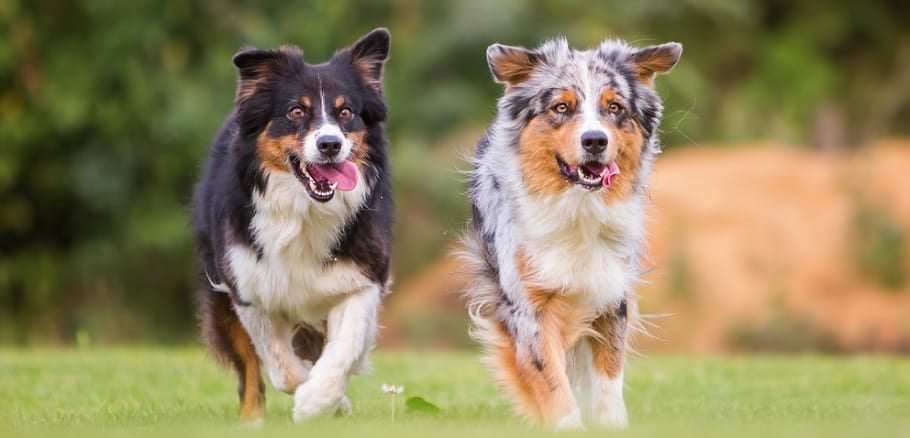
Genetics
How big an Australian Shepherd gets depends on genetics. The size of the parents will give a good indication of the size the offspring is likely to be.
If you have purchased a purebred pup, you will have a good idea of the size your pup is likely to grow to as you can judge by the mother’s size. A female pup will likely be the same size as the mom and a male pup will be a bit bigger.
Nutrition
The secret lies in the quality of dog food you give your dog – the better the quality, the better your dog will thrive. If the nutritional value of the dog food is high, you will also need less.
On average, an Australian Shepherd pup will need about 1¾ cups of high-quality food per day, spread over three meals until six months of age.
Depending on its age, size, and activity level, an adult Australian Shepherd, will need about 2½ cups of food per day, spread over two meals.
You will find that many breeders are in favor of premium dry food for Australian Shepherd puppies and adult dogs. Look out for the brands that are formulated for active breeds.
Physical Activity & Health
These dogs are an intelligent herding breed. They need more than a walk in the park. They need activities that will stimulate them mentally as well as physically.
Remember that puppies younger than nine months old shouldn’t do a lot of running, jumping, or climbing as it can harm their developing bones and joints.
These dogs have very strong herding instincts, so when you are in public, keep your dog on a leash otherwise he might be tempted to herd the neighborhood dogs or children.
Exercises that are popular with Aussies include walking (at least 20-30 minutes) jogging (alongside your bike), playing with and fetching a ball, stick or Frisbee, tug-of-war, and canine sports including agility trials and fly ball.
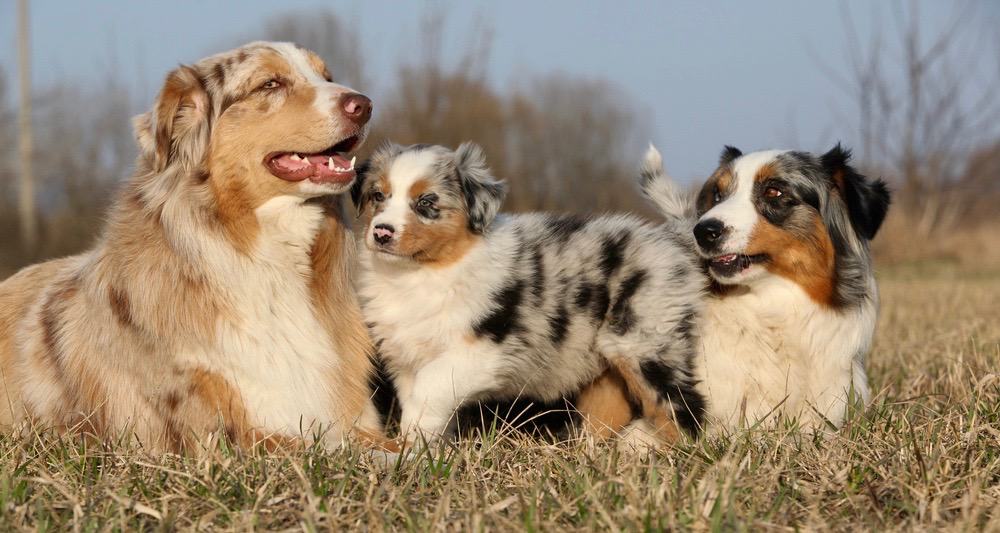
How To Identify An Overweight Australian Shepherd
It is not always easy to be sure if an adult Aussie is overweight or not. One way to determine if he is overweight, is to look at your dog from above.
The body of a healthy dog will be broader in the area near his head, narrowing gradually until the last few ribs. After a short narrow strip, the body should widen again towards the back.
If you don’t see a silhouette that broadens, narrows and then broadens again, your dog is overweight. In other words, if his body mass looks equally distributed along his body, he is probably overweight.
You can also see if your Aussie is overweight by looking at him from the side. Your dog’s tummy should be higher up than his ribcage. A shallow incline or no incline at all means that your dog is overweight.
His belly shouldn’t hang too low and shouldn’t move around too much when he walks.
How Long Are Australian Shepherds Pregnant?
Most dogs are pregnant for about 63 days. This time is calculated from the day that the dog ovulates to the day her puppies are born. Dogs’ pregnancies are divided into three trimesters of about 21 days each.
It’s not always easy to tell if a dog is pregnant, especially in the early stages when there aren’t any physical changes.
The first sign that your dog is pregnant, would be if she starts gaining weight. Your dog may seem a bit listless and she might lose her appetite for a while.
You will know for sure she’s pregnant when her nipples increase in size and appear slightly swollen. As the pregnancy progresses, your dog may start eating more than usual.
How Many Puppies Do Australian Shepherds Have?
The average Aussie litter is about 6-7 pups, but a female can give birth to up to 9 pups in one litter.

What If My Australian Shepherd Is Not the Right Weight?
From history, we can see that Aussies have always been very active and are at their best when they are herding livestock or doing some other work. A sedentary lifestyle doesn’t suit them and can lead to excess weight.
A sedentary lifestyle is not the only factor that can lead to excess weight in Aussies. There are many accounts online of Aussie owners who have noticed that their dogs gain extra weight after having been spayed or neutered. Even with a diet and ample exercise, the weight doesn’t seem to budge.
If you suspect that your Australian Shepherd is not the right weight, it’s best to take him to the vet. The vet will examine him and recommend the appropriate dog food for him as well as medication if necessary.
As a precautionary step, make sure that you keep to the recommended schedule of examinations and vaccinations. During the routine check-ups, your vet will check for common diseases and conditions, especially those that apply specifically to Aussies.
What Is the Life Expectancy of the Australian Shepherd?
The Australian Shepherd has an average lifespan of 12 to 13 years. Cancer is the most common cause of death. Epilepsy also causes a lot of deaths among these dogs.
The 2017 ASHGI Australian Shepherd Longevity Survey reports that almost a third of these dogs die of old age. It also mentions two dogs that lived to just over 18 years.
How Much Does It Cost To Own An Australian Shepherd?
An Australian Shepherd puppy can cost between $400 and $1,500. The average price is around $800.
In the first year, your dog will cost you around $2,700 and after that the cost will be a bit less adding up to around $1,500 per year. This figure can vary depending on the health of your dog, the treats that you buy, and whether you groom your dog at home.
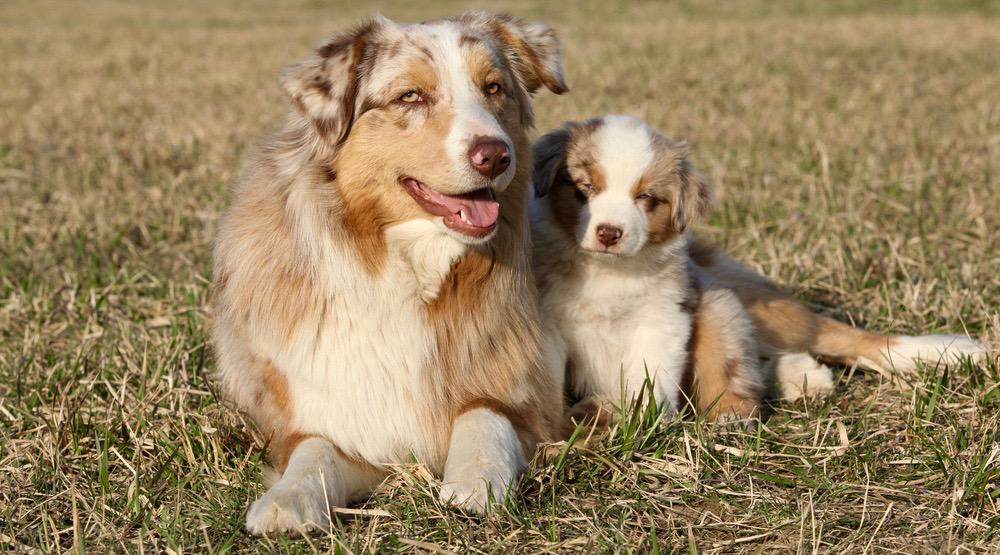
These figures include food, a dog license, veterinary costs, medical costs, training, grooming costs, treats, a microchip, and other essential supplies. It doesn’t include things like dog insurance, dog walking services, or a stay at the kennels.
Australian Shepherd Genetics and Common Health Problems
Certain hereditary medical conditions crop up more frequently with Australian Shepherds.
There is a genetic mutation that causes Australian Shepherds to suffer side effects from many drugs that are commonly used to treat health issues in dogs, including parasites and diarrhea. Some cancer medications may also cause problems.
Aussies are predisposed to hip and elbow dysplasia which can cause the joints to develop abnormally and can eventually lead to arthritis in older dogs.
Another degenerative disease that affects the hips is Legg-Calve-Perthes Disease.
Lymphoma is a type of cancer that particularly afflicts Australian Shepherds. With this disease, a dog develops abnormal lymphocytes (a type of white blood cell). The cancer can show up throughout the dog’s body. Fortunately, the condition can usually be treated very successfully.
Other hereditary diseases affecting Aussies include Hemangiosarcoma (a type of bleeding tumor), epilepsy, and different genetic eye conditions.
Aussies are also more likely to be affected by diabetes, Cushing’s, and hypothyroidism than other dogs.

